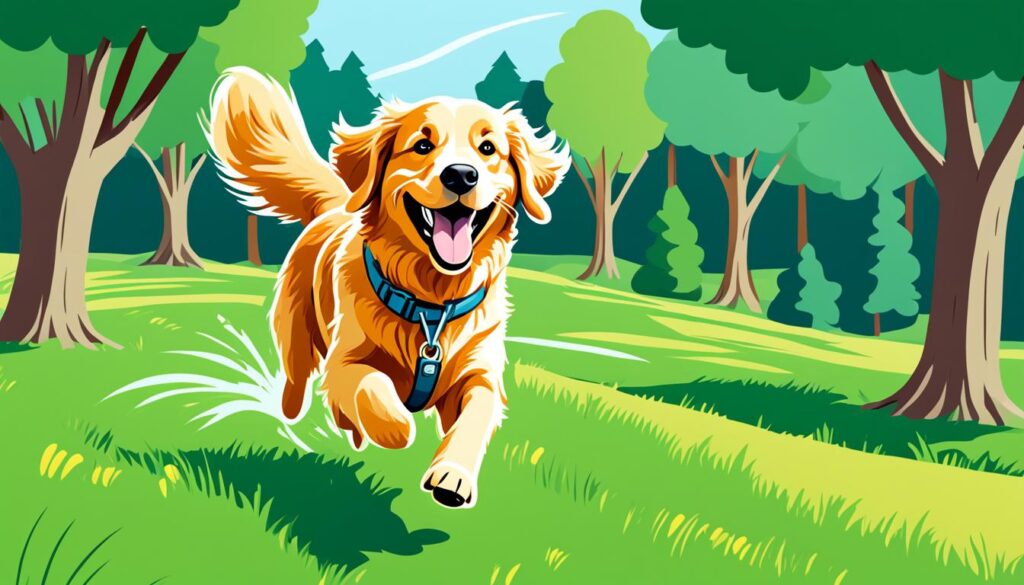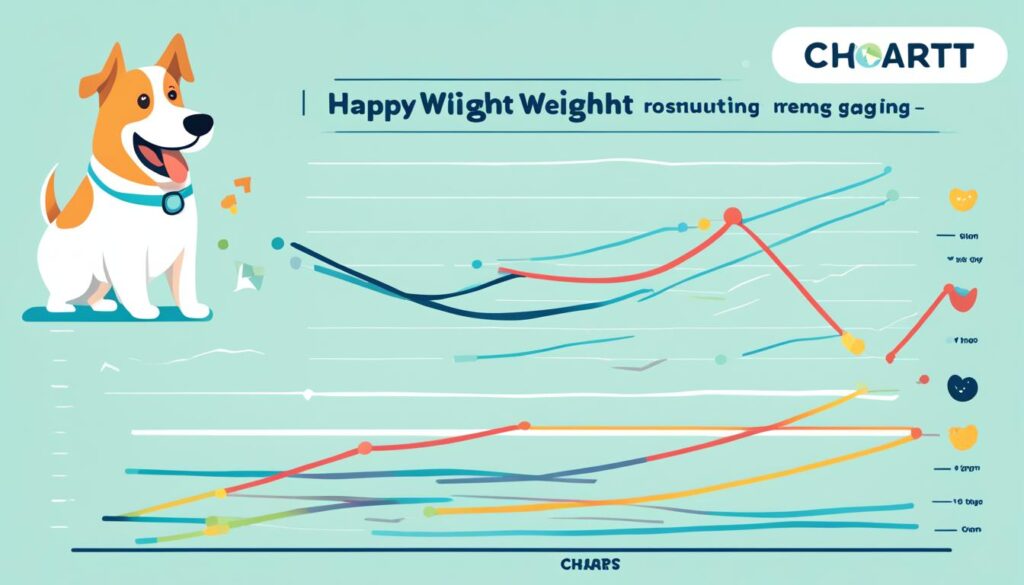Did you know that over 55% of dogs in the United States are overweight or obese? Maintaining an ideal weight is crucial for the health and well-being of our furry friends. Just like humans, dogs need effective weight management strategies to lead a healthy lifestyle. By implementing proper diet, exercise, and stress-reducing techniques, we can help our dogs maintain their ideal weight and live vibrant lives.
Key Takeaways:
- Over 55% of dogs in the United States are overweight or obese.
- Proper weight management is essential for dogs to lead a healthy lifestyle.
- Implementing a balanced diet, regular exercise, and stress reduction techniques can help dogs maintain their ideal weight.
- Setting realistic weight loss goals and monitoring progress are important strategies.
- Seeking support from healthcare professionals can provide guidance and encouragement throughout the weight management journey.
The Importance of a Balanced Diet for Dog Weight Management
A balanced diet is crucial for effective weight management in dogs. Providing the right nutrition while managing their weight is essential to ensure their overall health and well-being.
A balanced diet for dogs should include:
- Fruits and vegetables: These provide essential vitamins, minerals, and fiber for a healthy digestive system.
- Whole grains: They are a good source of carbohydrates and provide dogs with sustained energy throughout the day.
- Healthy fats: Omega-3 fatty acids, found in sources such as fish oil, can support joint health and promote a healthy coat.
- Protein sources: Lean meats, poultry, or high-quality dog food with adequate protein content are important for muscle maintenance.
When it comes to weight loss goals, portion control and calorie restriction may be necessary. By carefully measuring the amount of food given to dogs, pet owners can ensure that their furry friends are consuming the right amount of calories to support their weight loss journey.
Avoiding certain foods is also crucial for weight management in dogs. Refined carbohydrates, foods with added sugar, saturated fat, and trans fat should be minimized or avoided altogether. These types of foods can contribute to weight gain and increase the risk of health issues in dogs.
To illustrate the importance of a balanced diet for dog weight management, here is a table outlining the key elements of a healthy dog food:
| Nutrient | Benefits | Food Sources |
|---|---|---|
| Protein | Supports muscle maintenance and repair | Lean meats, poultry, fish, eggs |
| Fruits and vegetables | Provide essential vitamins, minerals, and fiber | Carrots, sweet potatoes, blueberries |
| Whole grains | Good source of carbohydrates and fiber | Brown rice, quinoa, oats |
| Healthy fats | Promote a healthy coat and support joint health | Fish oil, flaxseed, olive oil |
Remember to consult with a veterinarian or a pet nutritionist to determine the right balance of nutrients and portion sizes for your dog’s specific weight loss goals.
Providing a balanced diet for dogs not only supports their weight management goals but also ensures their overall health and vitality. Combined with regular exercise, stress reduction techniques, and setting realistic weight loss goals, a balanced diet plays a vital role in helping dogs achieve and maintain a healthy weight.
Regular Exercise for Dog Weight Management
Dogs need regular physical activity to maintain their ideal weight and lead a healthy lifestyle. Exercise plays a crucial role in dog weight management, helping them burn calories, maintain muscle mass, and improve overall fitness. According to the Centers for Disease Control and Prevention (CDC), dogs should engage in at least 150 minutes of moderate-intensity activity per week.
There are various activities that dogs can participate in to stay active and maintain their weight. Here are a few examples:
- Walking: Take your dog for daily walks to keep them active and ensure they get the exercise they need.
- Running: If your dog enjoys running, consider incorporating jogging sessions into their routine.
- Playing Fetch: Playing fetch is a great way to engage your dog in physical activity and keep them entertained.
- Swimming: Swimming is a low-impact exercise that can be exceptionally beneficial for dogs, as it helps them burn calories while being gentle on their joints.
Remember to start slow and gradually increase the intensity and duration of the exercise. It’s essential to consider your dog’s age, breed, and any pre-existing health conditions before implementing a new exercise routine.

“Regular exercise is essential for maintaining optimal weight in dogs. It promotes overall health and wellness, reduces the risk of obesity, and enhances their quality of life.” -Dr. Jane Carter, DVM
Strategies for Setting Realistic Weight Loss Goals for Dogs
Setting realistic weight loss goals for dogs is essential to ensure their long-term success in achieving a healthy weight. By establishing attainable objectives, you can help your furry friend make gradual progress and maintain motivation throughout their weight loss journey. Here are some expert tips to guide you:
1. Aim for Gradual, Steady Weight Loss
It’s important to prioritize your dog’s well-being by aiming for a gradual and steady weight loss. The Centers for Disease Control and Prevention (CDC) suggests a target range of 1-2 pounds per week for dogs. This approach allows for a sustainable and healthy weight loss process, minimizing the risk of adverse health effects.
2. Break Down Goals into Achievable Milestones
Breaking down the overall weight loss goal into smaller, achievable milestones can keep your dog motivated and enthusiastic throughout the process. Consider dividing the desired weight loss into weekly or monthly targets, making it easier for your pup to track progress and celebrate incremental successes.
3. Reward Milestones with Non-Food Incentives
As your dog achieves their weight loss milestones, consider rewarding them with non-food incentives. This can include extra playtime, a new toy, or a special outing to further reinforce their positive behavior and dedication to their weight loss goals. It’s crucial to avoid using food as a reward, as this can hinder their progress.
Incorporating these strategies into your dog’s weight loss journey can help them achieve and maintain a healthy weight. Remember, consult with your veterinarian for personalized guidance and support throughout the process.
| Benefits of Setting Realistic Goals | Tips to Support Your Dog’s Weight Loss Goals |
|---|---|
|
|
Monitoring Progress in Dog Weight Management
Dogs should regularly monitor their progress in weight management to track their success and make necessary adjustments. This allows dog owners to stay on top of their pet’s weight loss or maintenance journey and identify areas of improvement. By tracking weight loss, measuring success, and implementing effective dog weight management strategies, owners can ensure that their furry companions maintain a healthy weight and overall well-being.
One effective way to monitor progress is by regularly weighing the dog and recording the results. This can be done using a well-calibrated digital scale specifically designed for pets. By tracking weight loss or maintenance over time, owners can assess the effectiveness of their weight management strategies and make adjustments if needed.
Another measure of success is by visually observing the dog’s body condition score (BCS). The BCS is a visual assessment scale that helps determine whether a dog is underweight, overweight, or at an ideal weight. It takes into account factors such as rib visibility, waistline definition, and overall body shape. Online resources and guidelines from reputable veterinary organizations can assist in accurately determining a dog’s BCS.
| Tracking Methods | Benefits |
|---|---|
| Dog weight journal | Allows for detailed tracking of weight fluctuations and trends |
| Body condition scoring | Visual assessment of the dog’s body shape and condition |
| Progress photos | Visual documentation of changes in the dog’s physique over time |
| Regular veterinary check-ups | Professional guidance and monitoring of the dog’s weight management |
“Regularly monitoring your dog’s progress allows you to make data-driven decisions and implement changes that promote successful weight management,” says Dr. Emily Roberts, a renowned veterinarian specializing in pet nutrition and weight management. “Tracking weight loss, body condition scoring, and consulting with your veterinarian are important strategies that contribute to the overall success of your dog’s weight management journey.”
Monitoring progress also involves evaluating what is working well and making changes to goals if necessary. If a dog is not experiencing the desired weight loss or is not reaching the target body condition, adjustments can be made to their diet, exercise routine, or stress reduction techniques. Consulting with a veterinarian or participating in a community weight loss program can provide guidance and support throughout the process.
By monitoring progress and making necessary adjustments, dog owners can effectively manage their pet’s weight and ensure optimal health and longevity. It is crucial to view weight management as a long-term commitment and be proactive in implementing the best strategies to help dogs maintain a healthy weight and lead active, fulfilling lives.

The Role of Stress Reduction Techniques in Dog Weight Management
Stress can have a significant impact on weight management in dogs. Just like humans, dogs can experience stress, which can lead to weight gain or difficulties with weight loss. Therefore, incorporating stress reduction techniques into their weight management journey is crucial.
One effective stress management technique for dogs is diaphragmatic breathing. This technique involves deep, slow breaths that help calm their nervous system and promote relaxation. Teaching dogs diaphragmatic breathing can be done through gentle guidance and positive reinforcement.
Another valuable stress reduction intervention is engaging dogs in stress-relieving activities. This can include interactive play sessions, puzzle toys, or even massage therapy. These activities keep dogs mentally stimulated and provide them with an outlet to release stress, ultimately supporting their weight management efforts.
Building a network of support sources is also essential for stress reduction in dogs. Ensuring a positive and supportive environment helps dogs reduce anxiety and stress levels, positively affecting their overall well-being. This network can include family members, friends, or even professional trainers who can assist in stress management techniques.
Taking a holistic approach to weight management is key when it comes to stress reduction in dogs. By addressing their emotional and mental well-being, alongside physical exercise and a balanced diet, weight management goals can be more effectively achieved.
Conclusion
To maintain a healthy weight for dogs and achieve weight loss goals, a holistic approach that combines a balanced diet, regular exercise, stress reduction techniques, and realistic goal setting is essential. By following these strategies, dogs can lead a happier, more active life.
Implementing a balanced diet consisting of a variety of nutritious foods is crucial for weight management in dogs. Portion control and careful consideration of calorie intake are important for achieving weight loss goals.
Incorporating regular exercise into a dog’s routine helps burn calories, maintain muscle mass, and improve overall fitness. Activities such as walking, running, playing fetch, and swimming are excellent choices for weight management.
Monitoring progress, seeking guidance from healthcare professionals, and making necessary adjustments along the weight management journey contribute to long-term success. By following these strategies, dogs can attain and maintain a healthy weight, leading to a happier and more balanced life.
FAQ
What does weight management for dogs involve?
Weight management for dogs involves following a balanced diet, regular exercise, and stress-reducing techniques. Setting realistic goals, evaluating factors that promote weight gain, and monitoring progress are important strategies.
What is a balanced diet for dogs?
A balanced diet for dogs includes a variety of fruits, vegetables, whole grains, healthy fats, and protein sources. It is important to provide the right nutrition to dogs while managing their weight. For weight loss goals, portion control and calorie restriction may be necessary.
How much exercise do dogs need for weight management?
The Centers for Disease Control and Prevention (CDC) recommends at least 150 minutes of moderate-intensity activity per week for dogs. Exercise helps dogs burn calories, maintain muscle mass, and improve overall fitness. Activities such as walking, running, playing fetch, and swimming are beneficial for weight management in dogs.
How do I set realistic weight loss goals for my dog?
Setting realistic weight loss goals for dogs is important to ensure long-term success. Dogs should aim for a gradual, steady weight loss of about 1-2 pounds per week, as recommended by the CDC. Breaking down the overall weight loss goal into smaller, achievable milestones can help dogs stay motivated.
How do I monitor progress in weight management for my dog?
Dogs should regularly monitor their progress in weight management to track their success and make necessary adjustments. Revisiting goals, evaluating what is working well, and making changes to goals if necessary are important steps in the process.
How does stress affect weight management in dogs?
Stress can affect weight management in dogs. Techniques such as diaphragmatic breathing, stress-reducing interventions, and building a network of support sources can help dogs manage stress and maintain a healthy weight. Stress reduction is an important component of a holistic approach to weight management for dogs.
